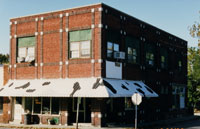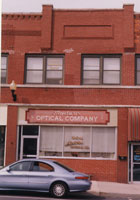In the fall of 1925, Truman formed a partnership, called Harry S. Truman and Company, with two business associates, Spencer Salisbury and Arthur Metzger. The partnership had effective control of Community Savings and Loan in Englewood (pictured left), about a mile southwest of Independence. Truman and his partners built Community Savings and Loan's assets from about $6,000 in October 1925 to about $27,000 in February 1926. Truman apparently did much of his work of soliciting deposits from his friend Ted Marks' taylor's shop in the Board of Trade Building, 10th Street and Wyandotte Avenue in Kansas City, and later from the office of a new partner, H. H. Halvorson, in the Waldheim Building at 11th Street and Main Street in Kansas City.
In April 1926, Truman became president of Community Savings and Loan and moved its main office to 204 North Liberty Street in Independence (pictured right). Truman also sold insurance, with Robert Barr, from this new office. By August 1927, the assets of Community Savings and Loan had risen to $110,176, though its managing agency, Harry S. Truman and Company, was apparently not doing well. In the fall of 1927, the partners revised their agreement and renamed their agency the Community Investment Company. Losses continued to mount, and in 1931 Truman, who had been presiding judge of Jackson County for about five years and was not able to devote much time to his savings and loan business, withdrew from the partnership. "My private business has gone to pot," Truman complained in a private memorandum written probably in late 1930. "I'll be worse than a pauper when I'm done." (From a handwritten manuscript written on Pickwick Hotel stationery, President's Secretary's Files)
Despite his worries, though, Truman apparently did not lose money from his savings and loan venture. He did, however, make an enemy, Spencer Salisbury, one of his partners, who spoke against him privately and publicly for many years and campaigned against him during his 1934 primary campaign for the Democratic nomination for U. S. Senator. Salisbury was eventually convicted of bank fraud for misrepresenting the assets of Community Savings and Loan.

